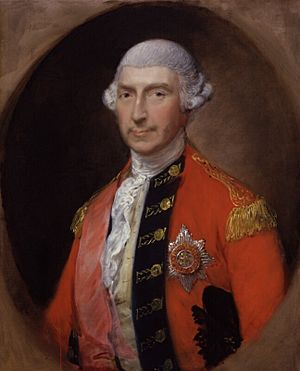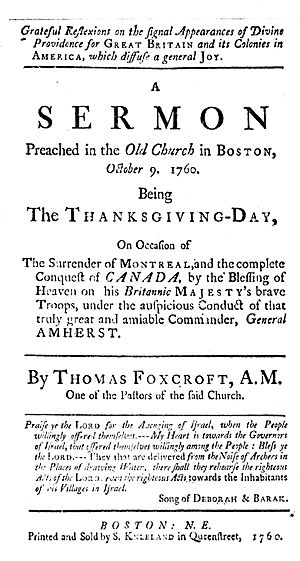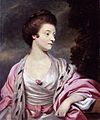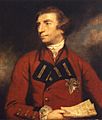Jeffery Amherst, 1st Baron Amherst facts for kids
Quick facts for kids
The Lord Amherst
|
|
|---|---|

Amherst by Thomas Gainsborough, c. 1785
|
|
| Commander-in-Chief, North America | |
| In office 1758–1763 |
|
| Crown Governor of Virginia | |
| In office 1759–1768 |
|
| Monarch | |
| Preceded by | John Campbell, 4th Earl of Loudoun |
| Succeeded by | Norborne Berkeley, 4th Baron Botetourt |
| Governor of the Province of Quebec | |
| In office 1760–1763 |
|
| Monarch | George III |
| Preceded by | Post created—replacing the French post of Governor General of New France |
| Succeeded by | James Murray |
| Personal details | |
| Born | 29 January 1717 Sevenoaks, Kent, Great Britain |
| Died | 3 August 1797 (aged 80) Sevenoaks, Kent, Great Britain |
| Resting place | Parish Church at Sevenoaks |
| Awards | Knight of the Order of the Bath |
| Signature |  |
| Military service | |
| Allegiance | Kingdom of Great Britain |
| Branch/service | British Army |
| Years of service | 1735–1795 |
| Rank | Field marshal |
| Commands |
|
| Battles/wars | |
Field Marshal Jeffery Amherst, 1st Baron Amherst (born January 29, 1717 – died August 3, 1797) was a high-ranking officer in the British Army. He is famous for leading Britain's successful effort to take over New France (which is now Canada) during the Seven Years' War. Under his command, British forces captured important cities like Louisbourg, Quebec City, and Montreal. He was also the first British Governor General in the lands that later became Canada. Many places in Canada and the United States are named after him.
However, Amherst's legacy is also controversial. During Pontiac's War, he expressed a desire to harm indigenous people. There are also claims that he approved giving blankets infected with smallpox to Native Americans as a weapon, especially during the Siege of Fort Pitt. Because of these actions, many people have re-evaluated his historical importance. For example, in 2019, the city of Montreal renamed a street that had been named after him to Rue Atateken, using a word from the Mohawk language.
Contents
Early Life and Military Start
Jeffery Amherst was born in Sevenoaks, England, on January 29, 1717. His father, also named Jeffrey Amherst, was a lawyer. From a young age, Jeffery worked as a page for the Duke of Dorset. He began his military career in 1735 as an ensign in the Grenadier Guards.
Amherst fought in the War of the Austrian Succession. He became an aide to General John Ligonier. He took part in battles like the Battle of Dettingen in June 1743 and the Battle of Fontenoy in May 1745. He was promoted to lieutenant colonel in December 1745. He also saw action at the Battle of Rocoux in October 1746 and the Battle of Lauffeld in July 1747.
Seven Years' War in North America
Amherst became very well known during the Seven Years' War. This war was called the French and Indian War in North America. He led the British attack on Louisbourg in June 1758. Louisbourg was an important French fortress on Cape Breton Island.
After this success, Amherst was made the commander-in-chief of the British army in North America in September 1758. He then led his army against French troops on Lake Champlain. He captured Fort Ticonderoga in July 1759. At the same time, other British armies were also making progress. One army under William Johnson captured Niagara. Another army led by James Wolfe captured Quebec in September 1759.
In July 1760, Amherst led an army down the Saint Lawrence River from Fort Oswego. He joined forces with other British commanders, Brigadier Murray from Quebec and Brigadier Haviland from Ile-aux-Noix. They surrounded and captured Montreal on September 8, 1760. This victory ended French rule in North America.
For this major victory, Amherst was made Governor-General of British North America in September 1760. He was also promoted to major-general in November 1760. In 1761, he was made a Knight of the Order of the Bath. From his base in New York, Amherst also helped send troops to the West Indies. These troops helped Britain capture Dominica in 1761 and Martinique and Cuba in 1762.
Pontiac's War and Controversy
A major uprising of many Native American tribes began in early 1763. This conflict is known as Pontiac's War. The tribes, including the Delawares, Shawnees, and Ottawas, were unhappy with the British taking over their lands after the war. They wanted to drive the British out of their territory.
During Pontiac's War, there was a very serious event involving the use of biological warfare. Colonel Henry Bouquet, the commander of Fort Pitt, ordered smallpox-infested blankets to be given to Native Americans. This happened when a group of them were attacking the fort in June 1763.
During a meeting on June 24, 1763, Captain Simeon Ecuyer gave two blankets and a handkerchief to representatives of the Native Americans. These items had been exposed to smallpox. The goal was to spread the disease among the Native Americans to end the attack. A trader named William Trent sent a bill to the British authorities. The bill stated that the purpose of giving the blankets was "to Convey the Smallpox to the Indians." This plan was approved by Thomas Gage, who was the Commander-in-Chief, North America at the time.
Amherst himself discussed the use of smallpox blankets in letters to Bouquet a month later. An outbreak of smallpox did occur among Native Americans in the Ohio Country from 1763 to 1764. However, it is not fully clear if this outbreak was a direct result of the Fort Pitt incident. Smallpox outbreaks happened naturally every few years among these groups.
Amherst was called back to Britain to discuss future military plans. He expected to be praised for his victories in Canada. Instead, he was asked to explain the Native American rebellion. He faced criticism from other military leaders. Despite this, he was promoted to lieutenant-general in March 1765.
American Revolutionary War
Amherst was given the title of Baron Amherst in May 1776. In March 1778, he was promoted to full general. In April 1778, he became Commander-in-Chief of the Forces, which meant he was part of the British government's Cabinet.
During the American Revolutionary War, the British commander in North America, William Howe, asked to be replaced. Amherst was considered for the job. However, he said it would take 75,000 troops to defeat the American rebellion. This number was too high for the government. So, Henry Clinton was chosen instead. After the British lost at Saratoga, Amherst argued for a more limited war in North America. He suggested focusing on defending Canada, Florida, and the West Indies, and putting more effort into the war at sea.
In 1779, Spain joined the war against Britain. France and Spain planned an invasion of Great Britain. Amherst was in charge of organizing Britain's land defenses. However, the invasion never happened.
Gordon Riots
In June 1780, Amherst was in charge of the British army when they had to stop the Gordon Riots in London. These riots were anti-Catholic. Amherst used the small London army to try and control the situation. However, local officials were slow to give permission for the troops to act forcefully.
More soldiers and local militias were brought in, increasing Amherst's forces to over 15,000. A form of martial law was declared, allowing troops to fire on crowds if necessary. Order was eventually restored. However, Amherst was worried about how difficult it was to stop the riots. After the Gordon Riots, Amherst had to resign as Commander-in-Chief in February 1782.
Later Life and Death
Amherst continued to hold military positions. In 1788, he was given a new title, Baron Amherst of Montreal. This title was special because it could be passed to his nephew, as Amherst had no children.
When the French Revolutionary Wars began, Amherst was called back as Commander-in-Chief of the Forces in January 1793. However, he was criticized for letting the army become weak. Many felt he was too old for the job.
Amherst retired from his post in February 1795. He was replaced by the Duke of York. On July 30, 1796, he was promoted to the highest rank, field marshal. He retired to his home at Montreal Park and died on August 3, 1797. He was buried in the Parish Church at Sevenoaks.
Legacy and Controversy
Many places are named after Jeffery Amherst, including:
- Amherstburg, Ontario
- Amherst, Massachusetts (home to Amherst College)
- Amherst, New Hampshire
- Amherst, Nova Scotia
- Amherst, New York
- Amherst County, Virginia
However, Amherst's actions and desire to harm indigenous people are now seen as a dark part of his history. Because of this, many places and groups have reconsidered using his name. For example, a 2007 article in The Beaver magazine listed Amherst as someone considered "contemptible" because he "supported plans of distributing smallpox-infested blankets to First Nations people."
In 2008, Mi'kmaq spiritual leader John Joe Sark said that having Fort Amherst Park in Prince Edward Island named after him was "disgusting." He compared it to naming a city in Jerusalem after Adolf Hitler. Sark and Mi'kmaq historian Daniel N. Paul have strongly supported changing the name. In 2016, Parks Canada said it would review the matter if a formal request was made.
In 2009, a Montreal City Councillor asked for Rue Amherst to be renamed. He said it was wrong to honor a man who supported harming Native Americans. On September 13, 2017, Montreal decided to rename the street. On June 21, 2019, the street was officially renamed Rue Atateken. This is a Kanien'kehá word meaning "those with whom one shares values."
In 2016, Amherst College stopped using "Lord Jeffery" as its mascot. The college also renamed the Lord Jeffery Inn, a hotel on campus, to the Inn on Boltwood in 2019.
Images for kids
-
On March 26, 1767, Jeffrey Amherst married Elizabeth, daughter of General George Cary (portrait by Sir Joshua Reynolds, 1767).
-
Jeffrey Amherst, 1st Baron Amherst, by Sir Joshua Reynolds.
See also
 In Spanish: Jeffrey Amherst para niños
In Spanish: Jeffrey Amherst para niños




